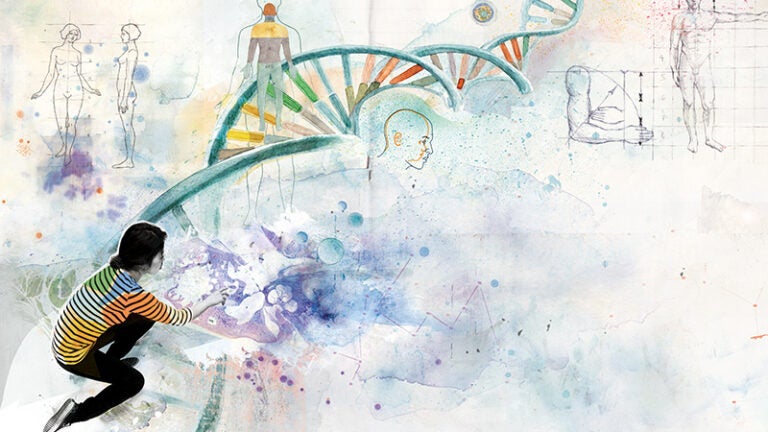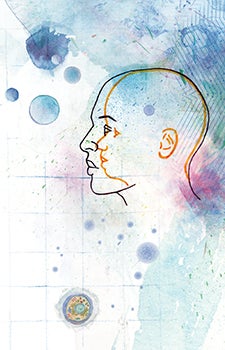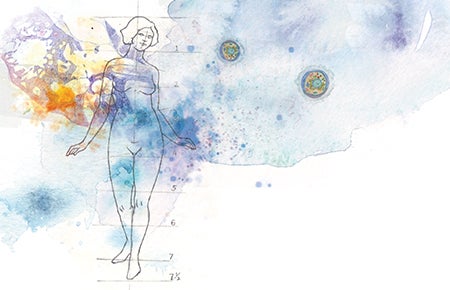
Molecular You
Upbringing and circumstance — and the consequences of a lifetime of decisions — all shape us to varying degrees. And the environment undoubtedly plays some role. But, at the core of it all is our genetics, the foundational biologic blueprint of our physical — and psychological — being.
Carried forward through the eons, each person’s DNA, copied from the preceding generations’ template, conveys a host of traits — simple features such as eye and hair color, and complex characteristics ranging from intellectual acuity to predisposition to disease.
And now, aided by unprecedented technology stemming from the Human Genome Project, each of us has access — at least in part — to the living source code behind our identities.
But are we ready to open this Pandora’s box? The mapping of the human genome has raised far more questions than it has answered. And concerns about the uses and utility of a person’s genomic data, along with ethical issues, dull the shiny optimism that once cast a glow on this crowning scientific achievement.
The code within
In humans, the genome comprises about 3 billion couplets of information called base pairs. Distributed among 46 chromosomes — arranged in 23 pairs — they encode the genes that control our biological processes, from the cells up.
The Human Genome Project, launched in 1990, gave the first complete sequence of those base pairs in 2003. More than a decade later, vast amounts of information — disease markers, common traits, even surprising links between humans and other hominids — have surfaced.
For example a multinational group of researchers published surprising results in 2010 comparing the human genome to that of Neanderthals, and showing the two species interbred. The findings sparked interest among the public and scientists alike, including Michael Waterman, University Professor and USC Associates Chair in Natural Sciences.

Genomic technology is revealing our molecular blueprints, granting unprecedented insight into our ancient past while opening new doors to our future well-being.
“I used to find human evolution really boring,” said Waterman, professor of biological sciences, computer science and mathematics. “I was just totally indifferent to it. But getting the Neanderthal sequence and realizing we had these percentages of it floating around in our genomes, now I’m absolutely fascinated with this.”
A founder and leader in the computational biology field, Waterman co-developed the Smith-Waterman algorithm for sequence comparison and the Lander-Waterman formula for physical mapping, two fundamental algorithms used for the mapping of human sequence information in the Human Genome Project.
Subsequent work suggests humans harbor genetic traces of a second or even third species, and despite striking findings such as these, Waterman believes we are just beginning to touch on the knowledge within our genomes.
“Oh, I think we’re just scratching the surface,” Waterman said. “We’ve learned so much compared to what we knew 20 or even just 10 years ago, but compared to what there is to learn, we are just babes.”
The plummeting cost of sequencing a genome may quicken the pace. An astronomical $10 million in 2006, the price tag is only about $1,000 a decade later. This increased cost-efficiency, driven by evolving technology, is allowing ever-increasing returns on the project’s initial investment of $2.7 billion, which was justified by the promise of near-unlimited improvements in human health.
Further, the technology is now within range of many consumers’ financial means, allowing them to catch a glimpse of their molecular selves, including their risk of disease. For many, this is where the real payoff begins.
The right to know — and heal — yourself
Rick White is effusive. His passion for the information held within the human genome — and its potential for saving lives — is nearly palpable. “This is something that we had to do,” he said. “This is something that we’re compelled to get out into the world and champion to make it happen.”
White, who earned his bachelor’s degree in anthropology from USC Dornsife in 1989, is co-founder of SureGenomics, a start-up company launched in 2013 that offers genomic sequencing services. An entrepreneur who found success as an Internet software designer, he saw an opportunity to use his background not only to provide people with information about their genome, but to educate them and give them a useful system for understanding what the information means and how they might use it.
“We run marker analysis, we put it on top of 3-D representations of sections of the body, then as you browse different categories of health and wellness — whether it’s kidney and urinary systems, lungs and breathing, immune system, whatever it is — you’re able to drill down on that area and create this personalized education platform,” White said. “The whole notion is that you don’t need to understand all of the science but you can understand what’s relevant to you.”
While this approach seems at face value to be a boon to personal health, providing this kind of information is not without controversy. The U.S. Food and Drug Administration has expressed concerns about companies delivering genetic risk information without getting clearance first, even going so far as to ban some firms from doing so, though they have since partially lifted the ban.
White and his business partners remain convinced the information is important for consumers to have — and it’s their right to have access.
“If you look in a marketplace of ideas, as Thurgood Marshall put it, and the ideas provided are wholly truthful representations, you can’t disrupt an individual’s ability to look at that information. That’s called censorship. That’s a First Amendment rights violation,” White said. “You heard the same things when WebMD first came out: ‘Oh, people shouldn’t really have this information.’ But they couldn’t stop WebMD from putting that information out because doing so would be a First Amendment rights violation.”

Genetics holds sway not just over our bodies, but also our minds. Information revealed through genomic sequencing may soon improve psychological therapies just as it has medical treatment.
Ralph Wedgwood, professor of philosophy, agrees with White’s position to some extent, but sees both sides of the issue. Though not a medical ethicist, his studies explore ethical theory as well as the implications of making rational decisions.
“Let’s suppose, just for the sake of argument, that this really is pretty useful information that can make a big difference to the kinds of treatments people can be given, to the kinds of plans people can make,” he said. “Then in general it looks like one simple point is just that this information is good; we should get it.”
At the same time, Wedgwood understands that humans are not always prepared to cope with information appropriately. “If they were the fantasy individuals of economics, who are perfectly rational and always judge the information with a cool, dispassionate eye, then it would be fine. But people might be vulnerable because we do panic and get anxious about our health.”
Part of the issue may lie in the inherent uncertainty of most genomic information. The presence or absence of genetic markers might motivate a person to make a medical choice when in fact those markers do not ensure a given outcome — they only speak to a level of risk.
This uncertainty is especially apparent for markers associated with behavioral traits.
Molecules to mind
Laura Baker is professor of psychology and director of the USC Twin Project. She investigates how heredity as well as the environment affect individual differences in human behavior as well as the genetic bases of reading disabilities, attention deficit disorders and conduct behavior problems in childhood and adolescence.
According to Baker, a shift in the 1970s and ’80s turned the psychology community toward recognizing the importance of genetic factors in shaping behavior.
“From intelligence and cognitive abilities to personalities and attitudes, and whether or not you’re conservative or liberal in your attitudes, it’s all influenced by genetic factors,” she said. “In fact, people have been hard-pressed to find any aspect of psychological function that is not influenced by genetics.”
The advent of genomic sequencing technologies has amplified efforts to pinpoint behavioral genes.
“Since the Human Genome Project and advances in molecular techniques, everyone has become focused on trying to discover genes for various traits.”
So far, however, the results have been inconclusive at best, which may reflect the complexity of the genetics that underlie behavior.
“Most of the things that we look at in psychology are what we would call multifactorial,” Baker said. “If there are genetic factors involved, it’s probably many genes acting in concert, maybe sometimes even interacting with each other, maybe even interacting with the environment. So genetic influences are not simple, they’re complex.”
Even so, Baker remains confident that eventually the information will prove highly useful in the field.
“This emphasizes the reality of tailored interventions. We want to find what the genes are and how they work, and maybe there are certain treatments that work better for some than others in the same way that we think of certain drugs that are maybe more efficient or effective for people of a certain genotype. Ultimately, we could think of doing genetic screening and tailoring treatments based upon those results.”
This concept and its promise of better health care is in part what drives White to continue his efforts.
The ultimate answer?
White’s belief that genetic information can improve or even save lives compels him to fight the current model of what he calls “standardized medicine.”
“In standardized medicine, you get sick, you take a drug; you get a cut, we sew it up. It’s a reactive model. We started to think, ‘Hey, if you actually had some of these data points, you could start to re-route yourself around the problems.’ ”
White in particular emphasizes concerns about adverse drug reactions. For him, it’s personal.
“My mom had an adverse drug reaction, and she passed away. And the thing is, there is knowledge that exists that could allow people to avoid that. There are 2.1 million adverse drug reactions in hospitals alone. It translates to 108,000 deaths every year.
“If we have pharmacogenomic information that allows you to know how you metabolize drugs — data that could protect you — that should be something that everybody has. So when you’re sick, they know what they can give you and what they can’t. It shouldn’t be, ‘Here, take this drug. Oh, it didn’t work? Okay, here, try this one.’ ”
White ultimately sees genomic data becoming part of each person’s health record. “Absolutely. Centerpiece.”
Waterman agrees. “At some point our genome is just going to be part of our health-care record. It’s inevitable.”
For White, that’s the ultimate power of knowing yourself at the genetic level. “That’s what turns standardized medicine from a money sink into something that’s efficient and personalized and terrific. But you have to start building it, and you have to give people access, and you have to give them tools that allow them to comprehend and learn about genetics.
“Ultimately, genomics saves us.”
Illustrations by Janice Kun for USC Dornsife Magazine
Read more stories from USC Dornsife Magazine’s Spring-Summer 2016 issue >>